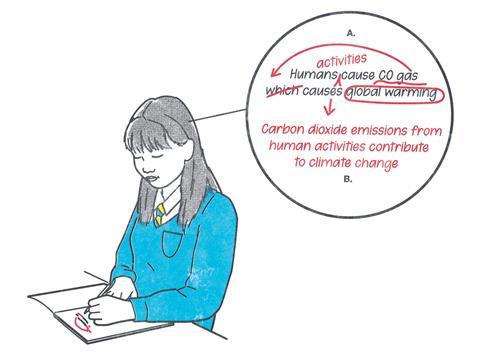Help your students acquire the writing skills they need to be better scientists, with this advice from an English teacher

Science resources such as booklets, textbooks and knowledge organisers are often full of word lists. Yet, recalling terminology is not the same as understanding or applying it. Explicit vocabulary instruction is required so that students grasp the meaning of exam questions and compose successful written responses.
Explicit vocabulary instruction
Explicit vocabulary instruction means unpacking the structure and meaning of words. Strategies such as the Frayer model, a graphic organiser, provide examples and non-examples alongside the definition and characteristics of a word. Similarly, you might unpack the etymology (their origins) as well as the morphology (the structure) of words. Take the word phosphorus for instance. Knowing that phos derives from the Latin for light might illuminate a student’s understanding.
By becoming better writers, students become better scientists
Despite the advantages of explicit vocabulary instruction, it does not necessarily follow that students will apply scientific language to well-structured written responses. They need more than knowledge of terminology. They need knowledge of the writing process itself. According to research, this process needs breaking down and making explicit in the classroom. The first step may be to acknowledge that writing is a skill.
Want more ideas for teaching literacy in science?
Embed literacy teaching into your curriculum using our resources and ideas to support learners’ reading and writing about science and develop their understanding of technical language.
A process approach to scientific writing
The Institute of Education Sciences (IES) offers a strategy for a process approach to writing in its pdf guide, Teaching students to write effectively. This also informed the Education Endowment Foundation’s Improving secondary science guidance report (pdf). Both suggest six parts to the writing process:
The Institute of Education Sciences (IES) offers a strategy for a process approach to writing in its guide, Teaching students to write effectively. This also informed the Education Endowment Foundation’s Improving secondary science guidance report. Both suggest six parts to the writing process:
- Planning: give opportunities for students to generate ideas before writing, for instance by gathering information through reading or classroom talk. In exam responses, students might bullet point key words to include in their answers.
- Goal setting: requires tightly defined success criteria in order to set the objectives for successful writing. Collating and sharing exemplars is useful to set the standard for success.
- Drafting: can be encouraged as you circulate. Use questioning to prompt students to select best words and sentences for their purpose.
- Evaluating: involves comparing a draft against the original goals. This might be through peer or self-review to identify improvement opportunities.
- Revising: direct students to make changes, for instance by removing, substituting or adding to what they have written.
- Editing: instruct and encourage students to proofread for literacy errors prior to completion.
These strategies are not steps in a sequence. The process is iterative, overlapping and cyclical. Each part can be revisited and refined continuously during writing. Seeing writing modelled will help students to understand this. Science teachers are used to modelling the steps required of a science practical, but how often do they apply the same approach to successful scientific writing?

This article is part of our Teaching science skills series, bringing together strategies and classroom activities to help your learners develop essential scientific skills, from literacy to risk assessment and more.
Going live! Modelling the process
Instead of providing perfect written exemplars, you can write live and narrate your thought process throughout. Using pen, paper and a classroom visualiser can be awkward and messy. Your handwriting may not be legible and opportunities to revise and edit are limited.
Live writing demonstrations are more effective when you type into an open document projected on a screen. Adjusting the font, layout and view settings allows for a better visual demonstration. Set the page to landscape and the font size to 30+ for best results. You can hit backspace as often as you like, explaining your decision making and asking students questions.
A useful writing strategy (also suggested by IES) is STAR:
- Substitute
- Take out
- Add
- Rearrange
A useful writing strategy (also suggested by IES) is STAR: Substitute; Take out; Add; and Rearrange.
You can easily model this when typing in a live demonstration. For instance, ask students to help: substitute overused words with precise words; take out any irrelevant information or needless repetitions; add details or clarification; rearrange information so that it is more logical.
The aim might be to improve students’ writing, but arguably, writing itself deepens understanding of scientific vocabulary. Slower, more deliberate writing practice demands that static word lists come alive. Ultimately, by becoming better writers, students become better scientists too.
Recommended reading and resources
- Use the context of plant-based plastics and give your 11–14 learners a chance to practise their writing and critical thinking.
- Practise writing and presenting practical investigations with this academic poster activity for learners aged 14–16.
- In this extended writing activity, 16–18 learners design the criteria to judge their written accounts before researching and writing on the topic of car exhaust gases.
- Read up on recent research to support writing as a tool for learning in science.
- Introduce your learners to Saba, who writes reports on air quality for large-scale industry, transport and energy projects.









No comments yet